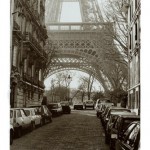Social Technologies List
In response to the Rip.Mix.Feed activity I created a Wiki in which we can list sites we have used in creating our projects, collaboratively creating a list of resources all in one place that we could access when we need. I have started us off with 25 sites and would love to have others add new sites and catagories from their own experiences!
The Wiki is called called Social Technologies List and can be accessed with the following information:
- username: metubc
- password: ubcmet
You can also log in through http://socialtechnologieslist.wiki-site.com/ . It would be so incredible to have an ongoing site we could all add to and pull from when needed! We can keep it up after the course ends and add to/pull from the site as needed.
~~Caroline~~
November 27, 2009 No Comments
Une Autre Vie
For my project I decided to create a slideshow which allowed me to create a sort of montage of abstract feelings, experiences and thoughts about living in Paris for two years.
In commencing the project I had an idea already in my head of what I wanted but the challenge was to locate programs which would do what I needed them to do and provide the dark, artsy effects I was looking for. Many of the sites allow for playful photo editing and slideshow production but I managed to locate one that allowed for a bit more.
I originally created the show through slide.com but found the program limiting despite its user-friendly approach. I realized it was not really me who was in control of the creation. I looked at mytimeline.com and while it provided what I was looking for in terms of effects, the background was unchangeable and did not give the right feel to it. I was searching for a site that would allow transitions, 15+ slides, text additions on the slides themselves, music, and…was free. I was asking for a lot!
Through Kizoa I found a program that did everything I wanted, with a few catches, however. The transition selection is great, slide number is perfect, but you need to pay a fee to either add text or your own music. In my stubborn quest to find free resources, I continued to search and could not locate a single site which would serve my needs and provide the right feel. After doing some creative work with Picnik, a free photo edit site which you can access online without downloading, I added text to the images. Within Kizoa, I located a song that would work and put it all together.
The experience for me was incredibly rich. I learned so much about available programs, their particular strengths and weaknesses, and furthered abilities to ‘get around’ the limitations of sites by using a patchwork approach of sites, knowledge, and skills.
Please click on the link below for the slideshow. My approach was to create something technological that represented my feelings… I aimed to cross the barrier between sterile machine and human feeling via the stereotypically sterile medium of the computer.
Wait for a quiet moment, sit back, relax, open the show to full screen, listen to the music and let the slideshow take you through the 15 slide, 2.5 minute experience.
November 27, 2009 1 Comment
I tried!
Well, my attempt didn’t turn out as I hoped. Things are a tad fuzzy, but perhaps that’s appropriate…
November 27, 2009 No Comments
Commentary 3: Web 2.0 and Emergent Multiliteracy Skills
Commentary #3: Web 2.0 and Emergent Multiliteracy Skills
Erin Gillespie
ETEC 540
November 27, 2009
Recently, I attended a literacy skills planning meeting. Various curricular text types were explained including procedural text, expositional text, descriptive text, persuasive text and narrative text. The literacy committee recommended that students and teachers use the Internet to increase exposure to the curricular text types and the skills inherent in each. Several suggestions involved Web 2.0 applications, such as blogging, collaborative document creation and wiki editing. Interestingly, the committee did not consider Web 2.0 itself as embodying an emergent form of multiliteracy skills. In digitally advanced nations, members of society read and write in Web 2.0. Why was this form of emergent multiliteracy overlooked by my curricular designers when we all share the vision of preparing students for the future with “real world” skills? Web 2.0’s emergent multiliteracies are meaningful and deserve a place in curriculum design.
In the article Web 2.0: A New Wave of Innovation for Teaching and Learning?, Bryan Alexander (2006) describes Web 2.0 applications and common practices within the concept. The major qualities of Web 2.0 are considered by Alexander (2006) to be content blocks called “microcontent”, openness, folksonomic metadata and social software. Alexander (2006) describes how services like social bookmarking, blogging and RSS feeds reflect the qualities of Web 2.0. He concludes that Web 2.0’s services, which are emergent and therefore risky, may not be considered highly in the field of education. In 2008, Alexander extends his argument with Web 2.0 and Emergent Multiliteracies. Concerning the status of Web 2.0 in the field of education, Alexander (2008) posits a more optimistic opinion. He describes the “archival instinct” of the Web and states that many pedagogical possibilities of Web 2.0 are explored by teachers and students (Alexander, 2008). The implication of increased value of Web 2.0’s emergent multiliteracies in education further strengthens the argument that this genre requires serious consideration by teachers and curriculum design teams.
Alexander (2008) describes Web 2.0 as being composed of social connection, microcontent, social filtering and openness, similar to his theory in 2006. Instructors must understand these qualities to identify pedagogical possibilities of emergent multiliteracies. Social connection is fostered by Web applications that literally connect people based on the variables of interest or personality (Alexander, 2008). Alexander (2008) lists a number of examples, such as blogs, FaceBook and Flickr to clarify. Microcontent is considered by Alexander (2008) to be small in size and to require a short investment in learning time. Alexander’s (2008) implication is clear in that microcontent makes Web authoring, and publishing, accessible and realistic in terms of time investment for teacher and student. Social filtering is the process of relating information between primary and secondary sources of Web content. Alexander (2008) considers it “the wisdom of the crowd”, and social filtering is evident in folksonomies created through tagging. Finally, Alexander’s (2006, 2008) fourth quality of “openness” for Web 2.0 content refers to any content posted on the Web for a global audience to see and use. Considering the literary text types I must teach this year, none seem as dynamic and exciting as the genre of emergent multiliteracies of Web 2.0.
To consolidate my teaching style with Web 2.0 multiliteracy, I must always keep in mind pedagogical possibilities related to Alexander’s (2008) four qualities: microcontent, openness, social filtering and social connection. On a practical level, how could a teacher reach the professional satisfaction of exposing students to this emergent text type in a meaningful way? One popular technique when teaching text types is to take advantage of the traditional method of storytelling. I have taught narrative text and descriptive text through storytelling. A challenging thought is how to use storytelling to teach emergent Web 2.0 multiliteracies! However, the emergent genre of Web 2.0 storytelling, as described by Alexander and Levine (2008), supports Alexander’s (2006, 2008) theory of Web 2.0 multiliteracies and pedagogical needs.
Alexander & Levine (2008) argue that Web 2.0 has changed the genre of digital storytelling by blending digital storytelling with Alexander’s (2006;2008) Web 2.0 qualities. Expensive desk top publishing programs are being replaced by free Web 2.0 tools, effectively shifting the pedagogical focus from mastering a tool to telling a story with a tool (Alexander & Levine, 2008). Web 2.0 digital storytelling is considered to be fiction or non-fiction with possible blurred boundaries, and is broad in scope (Alexander & Levine, 2008). The most significant difference between digital storytelling and Web 2.0 storytelling is the singular, linear flow of the former and the multidirectional flow of the latter (Alexander & Levine, 2008). With Web 2.0 qualities of social connectedness and openness, stories can virtually go in any direction, well beyond a linear form. Curriculum designers must recognize and design for these emergent qualities before advising teachers to use Web 2.0 tools to support literacy skills.
The emergent multiliteracies of Web 2.0 have meaningful literacy skills which should be included in curricular design. For example, Alexander and Levine (2008) note that content redesign is out of the hand of the primary creator with Web 2.0 storytelling. This implies that one challenge will be in teaching students about the consequences of openness and social filtering. In other words, an emerging skill embedded in Web 2.0 multiliteracy is Web 2.0 content analysis. The proposition by Alexander and Levine (2008) that there is a Web 2.0 storytelling genre exemplifies the need for continued research and increased pedagogical recognition concerning emergent multiliteracies. The revelation that each emergent Web 2.0 literacy genre may have its own set of multiliteracy skills should make every curricular designer and practitioner in digitally advanced educational environments sit up and take notice.
References
Alexander, B. (2006). Web 2.0: A new wave of innovation for teaching and learning? EDUCAUSE Review, 41(2), 32-44. Retrieved from http://net.educause.edu/ir/library/pdf/ERM0621.pdf.
Alexander, B. (2008). Web 2.0 and emergent multiliteracies. Theory into Practice, 47(2), 150-160. doi: 10.1080/00405840801992371
Alexander, B., & Levine, A. (2008). Web 2.0 storytelling: Emergence of a new genre. EDUCAUSE Review, 43(6), 40-56. Retrieved from http://www.educause.edu/EDUCAUSE+Review/EDUCAUSEReviewMagazineVolume43/Web20StorytellingEmergenceofaN/163262
November 27, 2009 3 Comments
Oldest Bible now in digital….
In the December, 2009 edition of National Geographic, I came across an article by A.R. Williams detailing how the oldest known New Testament is now available online at http://codexsinaiticus.org/en/ . According to Williams, the virtual version lets you see additions that were made and corrections that were overwritten. I tried it out and it is truly realistic. It took scholars, including the British Library, over four years to digitize! Amazing. The tools at http://codexsinaiticus.org/en/manuscript.aspx really give you the feeling that you are flipping through the ancient codex.
November 27, 2009 No Comments



